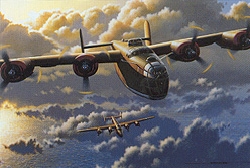|
|
| Liberators |
|
 |

|
 |
|
|
| DESCRIPTION |
 |
| 16 x 11.5 Inch Collector Size Unframed Lithograph $40.00
In 1938 Consolidated Aircraft was asked by the USAAC to join in production of America's only long range 4-engine bomber the Boeing B-17. However Mack Laddon the company's Chief design engineer convinced the Army that an alternative design incorporating the high aspect ratio wing design of David Davis would result in a long range heavy bomber superior to the Boeing B-17. The Army Air Corps contracted with Consolidated to build seven prototypes and these were delivered in 1940 for service trials. Consolidated Aircraft had substantial experience in producing long range flying boats most notable of which was the PBY Catalina. The B-24 incorporated the distinctive twin tailed design of Consolidated's flying boats and relative to the older but sleeker B-17 was quite an "ugly duckling." Despite its deceiving appearance the B-24 was produced in greater numbers (18000) than any other American aircraft during WW II and proved through experience to be one of the most versatile of all Allied aircraft. Nicknamed the "Liberator" by the British the B-24 served in many roles. In addition to its very effective use as a strategic bomber the aircraft proved very successful in anti-submarine activities and as a long-haul transport for troops fuel and supplies. The Liberator was the only American aircraft capable of non-stop transatlantic crossings during the war. First utilized by the French and British the B-24 is credited for helping the Allies win the war in the Atlantic where the aircraft's incredible range was an important asset. Germany's 1200 U-Boats sank over 2600 Allied ships during the War and in 1942 and 1943 losses were nearly unsustainable. Until the Liberators arrived Allied convoys lacked air cover for a 300 mile stretch of the Atlantic and it was in this area that wolfpacks of U-Boats took a devastating toll. The Liberator was utilized in virtually all theaters of operation during the war. The B-24 was produced in several variants of which the B-24D was the first to be mass produced. The B-24D was powered by four 1200 HP Pratt and Whitney Twin Wasp 14-cylinder radial engines which incorporated two-stage superchargers. The aircraft had a maximum speed of 303 MPH and a range of 2850 miles. Most Liberators were manned by a crew of nine or ten and typical armament consisted of ten machine guns. With an official bomb capacity of 8830 pounds the B-24D could pack quite a wallop. In his painting created expressly for The Stokes Collection artist Stan Stokes captures a pair of Liberators returning to base at dusk after a lengthy submarine patrol mission over the Atlantic in 1942. |
|


|